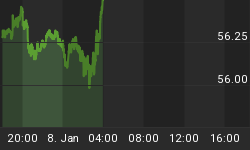The below analysis is similar to our daily signals in that it compares a longer moving average (the Fast measure) with a lesser period moving average of itself (the Slow measure), but in terms of months, not days. Whenever the Fast (14 month MA - green line) crosses above or below the Slow (5 month moving average of the 14 month - red line), we see an intermediate-term trend change. There have only been two in the past ten years. We may be about to get a third as a convergence has occurred that often early warns of a coming intermediate-term trend change. Where we find ourselves on December 1st, 2005 is at a point of convergence, where the Fast is at 1,549, slightly above the Slow at 1,518. Thus we sit at a point of early warning that a trend change down could be coming. No signal to that effect just yet.



As of Friday evening, both NASDAQ 100 key trend-finder indicators are at odds with each other, which is a "sideways" signal, warning that a clear-cut trend is not evident at this time. The NDX 14 day Stochastic Fast measure comes in at 68.00, above the Slow at 60.80, but not decisively above, thus the "sell" from October 27th remains. However, should the Fast rise more than 10 points above the Slow - and we are almost there - a "buy" signal would be generated. The NDX Purchasing Power Indicator comes in Friday at 106.73, remaining on the "buy" generated Thursday, December 1st. NASDAQ 100 volume came in Friday on its 10 day average, with upside volume at 62 percent, and advancing issues only able to muster 51 percent - a weak up day follow-through to Thursday's rally.

Above, we see that the recent Bearish Divergence between rising prices and a declining 10 day average Advance/Decline line in the NASDAQ 100 is lengthening, warning of a coming decline. Inside this Bearish Divergence was a small Bullish Divergence which foretold of Thursday's rally. But the Bearish Divergence is larger, so a meaningful decline is coming - most likely in early 2006.
At the top of the next page we see an Ending Diagonal Triangle in the NASDAQ 100, a 3-3-3- 3-3 wave, a-up, b-down, c-up, with d-down and e-up left to complete the pattern for wave C of (B) up. The Elliott Wave labeling suggests we should see a stair-step decline over the next few weeks, an a-b-c pattern down to a wave d bottom. Then one more spirited rally to a wave "e" top. Wave d does not have to touch the bottom boundary of the Rising Bearish Wedge - but odds are prices will come close. That targets the 1,525 to 1,550 area. Once (B) up completes, probably in early 2006, a major wave (C) decline of primary degree should unfold.
The bottom chart on the next page shows the Elliott Wave count since October 2002. The decline from the NASDAQ 100's all-time top of 4,816.35 on March 24th, 2000 to its low on October 8th, 2002 at 795.25 was primary degree wave (A) down, of an (A)-down, (B)-up, (C) down corrective Cycle wave II down. Since 2002, we have been in a primary degree wave (B) up that is weeks away at most from completion. Within the primary degree wave (B) up, we have seen an Intermediate degree a-b-c wave A which had decent buying power as denoted by its sharp vertical slope. That completed in January 2004. Intermediate wave B down was also an a-b-c affair and completed on August 13th, 2004 at 1,301.93. Since then prices have traced out the Ending Diagonal Triangle, a 3-3-3-3-3 wave C of (B) up.


If you would like a Free 30 day Trial Subscription to check out our remarkable buy/sell signals on the blue chip Dow Industrials and S&P 500, NASDAQ 100, or HUI Amex Gold Bugs Index, simply go to www.technicalindicatorindex.com, and click on the "Contact Us" button, and email us with your request, including a password you would prefer to use to access our site. A subscription gains you access to index buy/sell signals, our thrice weekly Market Analysis Newsletters, Traders Corner, Guest Articles, and our Archives. On October 13th, 2005 we closed out our latest Trader's Corner transaction with a 51.8 percent profit over a 21 trading day period (this is not an annualized figure). The prior trade garnered a 34 percent profit.
We integrate a broad base of technical analysis tools to help our clients build wealth. In addition to these buy/sell signal indicators, a subscription will gain you access to our newsletters that cover the major U.S. Equity, Bond, Commodity, Precious Metal, and Currency markets, using multiple tools simultaneously, including Elliott Wave Theory, Supply and Demand, Momentum Measures, Dow Theory, Chart Patterns, Cycles, Sentiment Measures, Fibonacci Ratio Measures for Price and Time turn-date targets, and Analogs of Current Price Behavior with the Past to name a few. Check us out today and start making money!
"Jesus said to him, "I am the way, and the truth, and the life;
No one comes to the Father, but through Me."
John 14:6
















